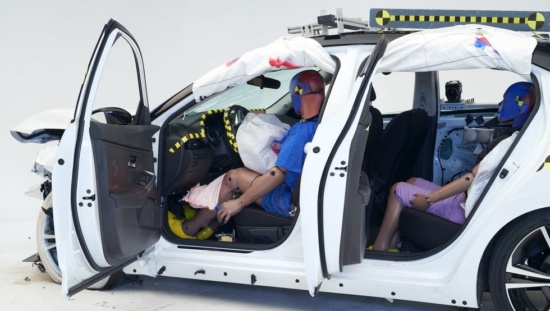Recent IIHS tests in the US reveal that the majority of small cars fail to offer sufficient rear-seat passenger protection. The organization’s oldest test revealed that the rear passenger dummy slips under the seat belt, resulting in the middle belt rising and putting pressure on the abdomen instead of securing the pelvis, thereby increasing the risk of internal injuries.
None of the vehicles tested received a satisfactory rating for rear seat passenger protection. The Honda Civic and Toyota Corolla achieved an “acceptable” rating, while the Kia Forte (Cerato), Nissan Sentra, and Subaru models also attained an “acceptable” rating. However, the Crosstrek received a “poor” rating in this regard.
The evaluated cars with a low rating demonstrated potential risks for rear seat passengers, including injuries to the head, neck, and chest. However, the Honda Civic and Toyota Corolla, which received an “acceptable” rating, offered a higher level of protection for occupants. It’s worth noting that during the tests, the dummy in the rear seat was positioned too close to the back of the front seat, which increased the risk of head injury.
The test results for this year align with the findings from the previous year’s tests, where the updated crash test was introduced. Among the 15 small SUVs evaluated, only two, namely the Ford Escape and the Volvo XC40, received a ‘Good’ rating.
IIHS has emphasized that there is a notable discrepancy in the safety test results between front seat passengers and rear seat passengers. The reason behind this difference can be attributed to the advancements in safety features that have been predominantly implemented in the front seats, such as advanced airbags and seat belts. These technological advancements have significantly enhanced the safety measures for occupants in the front seats, ensuring a higher level of protection during potential collisions.
However, it is concerning to note that these safety features are relatively less prevalent or even absent in the rear seats of many vehicles. As a result, rear seat passengers may not receive the same level of protection as their counterparts in the front seats, leading to potential vulnerabilities and a disparity in overall safety measures. Addressing this issue and striving for equal protection for all vehicle occupants, regardless of their seating positions, remains a critical aspect that the automotive industry and regulatory authorities need to consider in order to enhance overall passenger safety.




